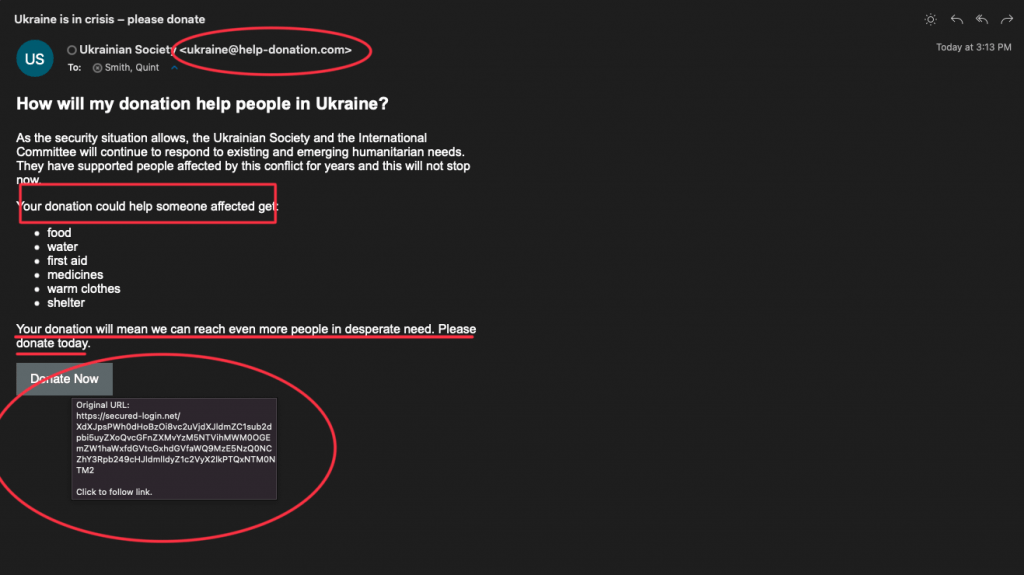This month, we’re focusing on another scam that preys on your emotions and altruistic intentions. This time, it involves cybercriminals taking advantage of fundraising for Ukraine. In just one week, legitimate fundraising for Ukraine mobilized more than $50 million in cryptocurrency. That kind of success always attracts opportunists who want their cut. This time, they’re posing as legitimate organizations seeking cryptocurrency donations for Ukraine. So far, these fraudulent solicitations are showing up primarily via social media and email.
The example phishing email below has some classic hallmarks of a scam. It includes an appeal to emotion—a plea for help to buy food, water, first aid, medicine, warm clothes, and shelter for those in desperate need. The sender’s address is not associated with a legitimate organization, and the “Donate Now” link directs your link somewhere other than the email content says it will.

Avoid this scam and other phishing scams by following our ten phishing safety tips and related guidance below.
Further Reading
- How to avoid fundraising scams when donating to charities for Ukraine : NPR
- Multiple warnings about Ukraine donation scams
Guidance for Reporting Phishing
10 Phishing Safety Tips
- Don’t click.Instead of clicking on any link in a suspicious email, type in the URL, or do a search on wustl.edu for the relevant department or page. Even if a website and/or URL in an email looks real, criminals can mask its true destination.
- Be skeptical of urgent requests.Phishing messages often make urgent requests or demands. When you detect a tone of urgency, slow down and verify the authenticity of the sender and the request by using official channels, rather than the information provided by the sender.
- Watch out for grammar, punctuation, and spelling mistakes. Phishing messages are often poorly written. Common hallmarks of phishing are incorrect spelling, improper punctuation, and poor grammar. If you receive an email with these problems, it may be a phishing attempt. Double-check the email address of the sender, don’t follow any links, and verify the authenticity of the request using official channels.
- Keep your information private. Never give out your passwords, credit card information, Social Security number, or other private information through email.
- Pick up the phone. If you have any reason to think that a department or organization really needs to hear from you, call them to verify any request for personal or sensitive information. Emails that say “urgent!”, use pressure tactics, or prey on fear are especially suspect. Do an online search for a contact phone number or use the contact number published in the WUSTL directory.
- Use secure websites and pay attention to security prompts. Always check if you are on a secure website before giving out private information. You can determine whether a website is secure by looking for the “https:” rather than just “http:” in the Web address bar or for the small lock icon in the Internet browser. If your browser cannot validate the authenticity of the website’s security certificate, you will be prompted. This is frequently a telltale sign of fraud, and it would be a good time to pick up the phone or report a suspicious message.
- Keep track of your data. Regularly log onto your online accounts and make sure that all your transactions are legitimate.
- Reset any account passwords that may have been compromised.
- Know what’s happening. Visit the Office of Information Security page ( https://informationsecurity.wustl.edu/home/alerts/ ) often and follow us on Twitter ( https://twitter.com/WUSTL_InfoSec ) to get the latest WashU Information Security Alerts.
- Report it. If you are a victim of an email scam, report it to our office by emailing infosec@wustl.edu). When you report a phishing attack, we will investigate it and if necessary, remove other instances of the attack from our systems. Reporting the attack will help protect others and our institution.
Additional Resources
Phishing | Office of Information Security | Washington University in St. Louis
Phishing 101 | Office of Information Security | Washington University in St. Louis